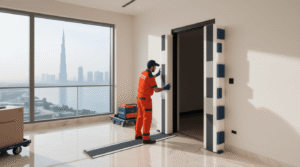Inter-emirate moves succeed on timing, stamina, and proof. Dubai’s official truck windows on Sheikh Mohammed bin Zayed Road compress legal movement into three daily slots, so a poor plan turns into queues, overtime, and missed handovers.
Fatigue is a quantifiable safety risk, not a vague concern. About 10–20 % of heavy-vehicle crashes to fatigue involvement, which makes stint length and rotation design a measurable control.
Compliance frames the operating day. Private-sector duty limits set 8 hours per day or 48 hours per week, so rotation and stop spacing must fit within those caps while preserving service windows.
This guide is practical and evidence-led. You will get a rotation model built on 90–120 minute stints, a rest-stop placement method for E11, E311, and E611, and a photo-verified seal SOP mapped to ISO 17712 and Dubai Customs package-count rules. Each element is backed by standards, law, and published research, then translated into checklists and targets you can deploy on the next dispatch.
What pushes UAE long-route moves from plan to penalty?
Timing windows, fatigue exposure, and weak seal evidence drive most penalties in long-route moves inside the UAE. Each factor is measurable, sourced, and preventable.
Timing compression on Dubai corridors
RTA restricts heavy vehicles on Sheikh Mohammed bin Zayed Road during three daily blocks: 06:30–08:30, 13:00–15:00, and 17:30–20:00. That removes 6.5 hours of road access per day on that section.
A separate evening restriction applies to Emirates Road from Al Awir toward Sharjah, effective 1 January 2025, from 17:30 to 20:00. This adds another 2.5 hours of blocked time if the route uses that segment.
- Impact for long-route moves inside the UAE: Plan legs to clear the morning and mid-day SMBZ blocks and avoid the Emirates Road evening ban toward Sharjah. Missed windows cause idle queues and schedule knock-on effects.
Fatigue as a quantifiable exposure
The National Academies estimate that about 10 to 20 % of truck and bus crashes involve fatigued drivers. This is a crash involvement range, not a minor signal. Rotation design, therefore, uses short stints.
- Implication for crew rotation: Two qualified drivers, three short legs on 400 to 500 km routes, and a fixed break schedule aligned to corridor windows. Use stints under two hours to align with the fatigue evidence band.
Seal evidence and chain of custody
ISO 17712:2013 sets the classification and acceptance procedures for mechanical seals used on container and vehicle doors. High-security bolt or cable seals fall under this framework. Dubai Customs policy requires that the number of packages be stated in detail in the manifest and in the customs declaration. Seal IDs and time-stamped photos must reconcile with those counts to preserve the chain of custody during disputes.
Why this matters to operations now
Missing a single Dubai peak window can force a two-to-three-hour delay on approach segments, escalate duty utilization, and compromise arrival slots. Fatigue-linked errors rise as stint duration drifts past two hours. Sealing evidence gaps weakens dispute positions when package counts are challenged. The solution is precise timing against RTA windows, short-stint rotation, and ISO-referenced seal logs that mirror customs counts.
What exactly is the “step teams skip” and why does it trigger claims?
Teams skip a time-stamped seal photo plus a log cross-check at origin and again at the first planned stop; that single omission breaks the chain of custody and weakens claims defenses.
Why skipping the step becomes a claim (regional loss profile)
Independent loss data shows documentation gaps amplify loss exposure. TT Club and BSI report that over three-quarters (≈76%) of cargo theft incidents in the Middle East occur at logistics hubs and warehouses, with free-trade zones noted as hotspots; weak seal programs and poor documentation complicate recovery and liability allocation.
Takeaways
- Early, verifiable proof at origin and the first stop covers the riskiest handoffs in long-route moves inside the UAE and strengthens dispute positions.
- Seal evidence that reconciles to declared package counts reduces ambiguity in post-clearance reviews and insurance assessments.
SOP that closes the gap (do this, every time)
- Apply and photograph
Fit an ISO 17712 high-security seal to each access door after loading. Take clear photos that show the locked hasp and the entire seal number; note the ISO class on the consignment.
- Log and reconcile
Record seal ID, date, time, location, vehicle ID, and crew signatures in a single seal log; reconcile IDs to packing-list carton ranges and to the manifest’s package totals.
- First-stop cross-check
At the first planned stop, repeat photos, verify IDs against the log, and note odometer and time; if a seal is changed, use an ISO-equivalent seal and record the reason with new photos.
- Retention and audit
Store the seal log, photo sets, packing list, and manifest for five years to satisfy GCC record-keeping and post-clearance audit demands.
Which duty limits anchor crew rotation inside the UAE?
Long-route moves inside the UAE anchor crew rotation to 8 hours per day and 48 hours per week for private-sector workers, with at least one hour of break after five consecutive hours of work. Plans must document breaks and align stints to these caps.
Ramadan adjustment reduces daily hours by 2 hours unless the job requires otherwise. Schedulers should reflect this in duty rosters for long-route moves.
Mandatory rest within the duty day
Workers who perform five consecutive hours must receive one or more breaks totaling at least one hour. Breaks are not counted in paid working time. This requirement is operational for drivers and loaders assigned to long-route moves inside the UAE.
Why rotation uses ≤120-minute driving stints
Fatigue is a measurable crash factor in heavy-vehicle safety literature. National Academies reviews estimate 10–20 % fatigue involvement in truck and bus crashes. NTSB analyses of fatal-to-driver cases report about 31 % fatigue involvement in selected samples. Short stints with planned breaks reduce exposure inside the legal duty window.
Rotation model that fits the caps
Two licensed drivers share three short legs on inter-emirate corridors. Each stint lasts 90–120 minutes with a documented break at every stop. The roster totals ≤8 duty hours and remains audit-ready for MoHRE inspections.
Sample roster built to the limits
- Driver A: 90 minutes driving, stop, logged break.
- Driver B: 90–120 minutes driving, stop, logged break.
- Driver A: 90–120 minutes driving to the yard, logged a break at entry.
- Administrative time: pre-trip checks, seal photos, and post-trip paperwork within remaining duty.
The day ends with ≤8 duty hours, with all breaks documented and stints ≤120 minutes.
Quick checklist for schedulers
- Print the 8/48 limits and the five-hour break rule on the driver brief.
- Structure legs as 90–120 minute stints and log every break.
- Adjust rosters by –2 hours during Ramadan when applicable.
What rotation model reduces fatigue and preserves legal windows?
Swap at planned service nodes that align with RTA peak-hour truck windows. This follows fatigue evidence and local timing rules.
Use dense service nodes for reliable swaps
ADNOC Distribution reported about 840 service stations across the UAE, KSA, and Egypt as of May 2024, and a target of 1,000 within five years. This density lets planners standardize stop locations on E11, E311, and E611 with fuel, parking, and facilities.
Three-leg rotation mapped to UAE constraints
Use this template for E11 or E311 corridors. Replace node names with actual stations or RTA truck rest areas.
| Leg | Driver | Target stint | Planned node type | Required actions | Constraint check |
|---|---|---|---|---|---|
| 1 | A | 90–120 min | ADNOC station or RTA rest area | Fuel, tire check, seal photo set, log update, swap | Clear 06:30–08:30 SMBZ block by timing departure. |
| 2 | B | 90–120 min | ADNOC station | Seal ID verify, odometer, roster sign, swap | Avoid the 13:00–15:00 restriction if traversing SMBZ. |
| 3 | A | 90–120 min | Destination yard | Arrival checks, seal break photos, POD | Avoid 17:30–20:00 SMBZ evening block where applicable. |
How to plan legs by speed and distance
Compute distance per leg as corridor average speed multiplied by 1.5 to 2.0 hours. Urban averages often 50 to 70 km per hour. Open sections often run at 80 to 100 km per hour. The resulting leg length is about 75 to 200 km before each stop. This keeps the rotation inside the fatigue evidence band.
Planning steps
- Map the route segment that intersects SMBZ. Mark the three RTA peak windows.
- Place Leg 1 to clear the first window. Fix the first stop at 90 to 120 minutes.
- Place Leg 2 to land before or after the mid-day block.
- Place Leg 3 to arrive outside the evening block.
- Select ADNOC nodes with safe parking and service bays for all stops.
Quick checklist for dispatch
- Two drivers assigned with timers set to 120 minutes maximum per stint.
- RTA peak windows printed on the brief for SMBZ.
- Swap nodes chosen from ADNOC’s domestic network of 551 UAE stations at year-end 2024.
- Seal the photo and log cross-check at the first stop to support the chain of custody.
Where should rest-stops sit on Dubai corridors if the objective is zero queue exposure?
Use RTA-built truck rest areas and large ADNOC service stations as fixed nodes, then schedule each leg to cross Sheikh Mohammed bin Zayed (SMBZ) Road after 08:30, after 15:00, and after 20:00. Dubai confirms three daily truck blocks on SMBZ; WAM confirms 10 of 16 truck rest stops delivered across six freight axes.
The infrastructure you can rely on
- Dedicated rest areas: Program covers six roads: SMBZ, Emirates, Dubai–Hatta, Dubai–Al Ain, Jebel Ali–Lehbab, Al Awir. 10/16 is complete. Use these, not hard shoulders.
- Service station density: ADNOC reports 551 UAE stations (FY2024). That scale supports predictable 15-minute inspections, crew swaps, and refueling on E11, E311, E611.
The time windows you must clear
- SMBZ truck restrictions: 06:30–08:30, 13:00–15:00, 17:30–20:00, Ras Al Khor ↔ Sharjah section. Plan to cross just after each edge to avoid tail-end queues.
- Additional rule (Emirates Road → Sharjah): evening ban 17:30–20:00 effective 1 Jan 2025. Stage upstream and cross ≥20:00 when that arc is en route.
“Arc-Node-Edge” method (fast planning)
- Arc: Mark the next restricted corridor segment (SMBZ or Emirates Road towards Sharjah).
- Node: Pick a formal RTA rest area or a named ADNOC station with truck parking and lighting.
- Edge: Schedule departure to cross just after the block’s edge (08:30 / 15:00 / 20:00). That timing collapses queue risk.
Which seal types and records pass audits for moving trucks and containers?
Use ISO 17712:2013 high-security bolt or cable seals and keep a complete seal log that reconciles with Dubai Customs package counts and is retained for five years. This combination meets accepted standards and audit expectations.
Standards and acceptance criteria
ISO 17712:2013 sets uniform procedures for classification, acceptance, and withdrawal of mechanical seals used on freight containers and vehicle doors; the standard recognizes indicative, security, and high-security types, with high-security bolt and cable seals accepted in international commerce.
U.S. CBP’s CTPAT guidance requires high-security seals that meet or exceed ISO 17712 and instructs operators to maintain documentation proving compliance, which aligns with seal control on long-route moves inside the UAE.
Key points
- Specify ISO 17712:2013 on consignment documents and the seal log.
- Prefer high-security bolt or cable seals for truck and container doors where tamper resistance is required.
Customs linkage: counts, logs, and retention
Dubai Customs policy CP23E requires the number of packages to be stated in detail in both the manifest and the customs declaration; auditors can request supporting evidence during post-clearance checks.
Dubai Customs service guidance, under GCC Common Customs Law practice, states that declaration records must be retained for five years from the date of clearance; this makes long-route seal logs and photo sets part of the auditable trail.
Seal selection and record fields for audit readiness
| Item | Requirement | Why it matters |
|---|---|---|
| Seal type | High-security bolt or cable | Recognized under ISO 17712 for doors and containers |
| Standard reference | ISO 17712:2013 on documents and in the log | Proves classification and acceptance |
| Seal log fields | Seal ID, ISO class, door position, date and time, location, vehicle ID, crew signatures | Links custody to a specific vehicle and door |
| Photo evidence | Clear images of the locked hasp and a readable number at the origin and the first stop | Converts hardware into admissible proof |
| Count reconciliation | Match seal IDs to packing-list cartons and manifest totals | Satisfies Dubai Customs package-count requirement |
| Retention period | Maintain the file for 5 years | Meets GCC record-keeping practice and audit scope |
Seal Control Procedure for UAE Long Routes
- Apply an ISO 17712 high-security seal to each access door after loading; note the ISO class on paperwork.
- Photograph the locked hasp with a fully readable seal number at the origin and at the first planned stop.
- Record in one log: seal ID, ISO class, door position, date, time, location or GPS, vehicle ID, and crew signatures.
- Reconcile seal IDs with packing-list carton ranges and manifest package totals.
- Retain the log and photos with the customs declaration file for ≥5 years.
Which documents must travel with sealed inventory on inter-emirate moves?
Carry the consignment note, packing list (with carton ranges), customs manifest and declaration (with package counts stated in detail), a seal log with photos, the driver’s duty roster, and the rest-stop plan. Dubai Customs policy CP23E requires a detailed number of packages on both the manifest and the declaration, and post-clearance audit rules require five-year record retention.
Document set and required content
- Consignment note: Shipment identifiers, consignor/consignee, origin–destination, vehicle ID, and service level; used operationally with roadside checks.
- Packing list: Itemized contents by carton range, dimensions/weights, and package totals that will reconcile to the manifest and declaration. Dubai Customs mandates that package counts be stated in detail on customs documents.
- Manifest + Customs Declaration: Electronic manifest reference, bill of lading/air waybill link, HS codes, values, and number of packages; Dubai Trade documentation shows structured manifest fields used by Dubai Customs systems.
- Seal log with photos: Per-door seal ID, ISO 17712 class, date/time, precise location, vehicle ID, crew signatures, and photos of locked hasps with readable seal numbers; ISO 17712 is the accepted seal framework in international cargo programs.
- Driver duty roster: Names, license numbers, stint timetable, and break records to evidence legal duty design if queried alongside the trip file.
- Rest-stop plan: Node names (RTA rest areas or ADNOC stations), planned inspection times, and RTA window edges to demonstrate schedule control.
Audit and retention requirements
Dubai Customs’ service guidance (aligned to GCC Common Customs Law) states companies must retain customs declarations and supporting records for five years and provide them on request during a post-clearance audit. Keep the seal log, photos, packing list, manifest, and declaration together for the full retention period.
Operational timelines also matter: a policy update extended the period to submit required supporting documents within 30 days of initial filing; plan document compilation accordingly.
Documents to carry with sealed inventory on the UAE long routes
| Document | Required fields to include | How it ties to compliance |
|---|---|---|
| Consignment Note | Shipment IDs, parties, route, vehicle ID | Proves custody and routing during roadside checks |
| Packing List | Item lines, carton ranges, weights, package totals | Totals must reconcile with manifest & declaration counts |
| Manifest (electronic) | BL/AWB, HS codes, values, package count, agent codes | Forms part of the customs record; structured fields in Dubai systems |
| Customs Declaration | Consignee, HS codes, values, and number of packages in detail | CP23E requires detailed package numbers on the declaration |
| Seal Log + Photos | Seal ID, ISO 17712 class, door position, date/time, location, vehicle, crew signatures; readable photos | Chain-of-custody evidence; ISO 17712 is the recognized seal standard |
| Driver Duty Roster | Drivers, license numbers, stint schedule, breaks | Supports legality and safety if reviewed with the trip file |
| Rest-Stop Plan | Node names, planned inspection times, RTA peak-window edges | Shows preplanned compliance with movement windows |
Implementation guidance
- Reconcile counts: Ensure packing-list totals = manifest totals = declaration totals; mismatches trigger post-clearance queries.
- Bundle evidence: Store the seal log + photo set in the same folder as the declaration and packing list to satisfy five-year retention and audit readiness.
- File on time: Track the 30-day supporting-document submission window after initial filing to avoid penalties.
Strategic Close: Long-Route Moves Inside the UAE
Long-route moves inside the UAE perform best when rotation, rest-stop logic, and inventory seals work as one system.
Plan duty around 8 hours per day and 48 hours per week. Keep each driving stint at 90 to 120 minutes with planned breaks. Cross Sheikh Mohammed bin Zayed Road after 08:30, after 15:00, and after 20:00 to avoid queues. Place stops at formal RTA rest areas and large ADNOC stations. Apply ISO 17712 high-security seals, take time-stamped photos at origin and the first stop, and reconcile seal IDs with manifest counts. Keep the full file for five years.
What to do now
- Lock a two-driver, three-leg rotation for E11, E311, and E611.
- Pre-book stop nodes that meet RTA timing windows.
- Use a single seal log and photo protocol across all trips.
- Audit one recent job against these controls and close gaps within seven days.
Result: fewer delays, stronger evidence, and cleaner post-clearance reviews. The skipped step becomes documented proof. The schedule becomes predictable.
Frequently Asked Questions (FAQs)
What defines a long-route move inside the UAE?
A long-route move crosses emirate boundaries and exceeds one standard driving shift; examples include E11 Abu Dhabi to Ras Al Khaimah, E311 to Fujairah, and E611 bypass segments that intersect Dubai movement windows.
How many daily truck windows apply on Sheikh Mohammed bin Zayed Road?
Three windows apply to the regulated section: 06:30–08:30, 13:00–15:00, and 17:30–20:00; plans should cross immediately after each window edge to avoid queues.
What rotation model reduces fatigue on long corridors?
A two-driver, three-leg model with 90 to 120 minute stints reduces fatigue exposure and keeps duty within legal limits while aligning to corridor windows.
Why are ISO 17712 seals required for sealed inventory?
ISO 17712 classifies mechanical seals and sets acceptance criteria; high-security bolt or cable seals provide recognized tamper evidence for truck and container doors.
Which records must travel with sealed inventory on inter-emirate moves?
Carry the consignment note, packing list with carton ranges, manifest and declaration with package counts, a seal log with photos, the driver’s duty roster, and the rest-stop plan.
How should seals be documented at origin and en route?
Apply the seal, photograph the locked hasp with a readable ID, record the ID, class, time, and location in one log, and repeat the photo plus log check at the first stop and at custody transfers.
What retention period applies to customs and seal documents?
Retain declarations, manifests, packing lists, seal logs, and photo evidence for five years to meet common GCC post-clearance audit practice.
How do rest-stop nodes reduce delay risk in Dubai?
Formal RTA rest areas and large ADNOC stations provide parking, lighting, and services, which allow 15-minute inspections, swaps, and refuel without shoulder stops that create queues.
What is the fastest way to calculate leg length between stops?
Multiply corridor average speed by 1.5 to 2.0 hours; urban averages often yield 75 to 120 km legs, and open sections yield 120 to 200 km before the next planned stop.
What single step prevents most seal disputes?
Time-stamped photos and a log cross-check at origin and the first stop prevent most disputes by linking the physical seal ID to counts on the manifest and packing list.





